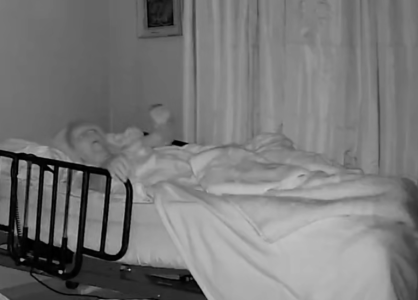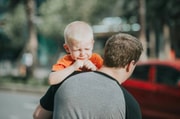Hospice nurse reveals what the dying see—and it’s giving people goosebumps
- Replies 0
In life’s final moments, something remarkable may be happening—something science can't yet fully explain.
For those working closest to death, like Los Angeles-based hospice nurse Julie McFadden, the stories are both astonishing and comforting.
With nearly 20 years of experience by the bedside, McFadden has witnessed firsthand what many call “the thinning of the veil”—when the boundary between this world and the next seems to dissolve.
Now, she's using her voice and social media following to share what she sees—and what the dying may be seeing too.
One of the most compelling patterns McFadden has observed is known as “visioning” or deathbed visions.
According to her, these often begin three to four weeks before death, and she estimates they occur in as many as 80 percent of the patients she cares for.
In these moments, patients frequently describe seeing deceased family members, spiritual figures, or even beloved pets who have passed on. Others report viewing vivid landscapes, bright light, or calming presences.
“They show that our loved ones aren’t suffering as they die,” McFadden said. “On the contrary, many of them are having beautiful visions—meeting with long-dead loved ones or having spiritual experiences in line with their deeply held beliefs.”
These experiences often bring peace—not just to the patients, but to their families too.
Alongside visioning, McFadden frequently sees something she calls the “death stare” or “death reach”—typically appearing one to two weeks before death.
More like this: 24 minutes dead: A parent's near-death experience and what it taught her about life beyond!
Patients may begin staring off at a fixed point on the wall or ceiling. Some lift their arms gently, reaching out toward someone or something unseen.
In one moving example, McFadden recounted a video shared online by a user named @rugersmomma1, showing an elderly woman reaching into the darkness during her final days.
Source: @rugersmomma1 / TikTok
A whisper of the word “mama” is heard—believed by her family to be the voice of her deceased daughter, welcoming her from beyond.
In another clip sent to McFadden, a woman was filmed by her daughter just two weeks before passing. The elderly woman appears visibly joyful, speaking to people no one else could see and raising her hands to greet them.
What McFadden finds especially compelling is that her patients are aware of what they’re experiencing.
More like this: “I popped out the top of my head”: Woman shares chilling vision during life-saving surgery
“What I also find interesting is that, most of the time, my hospice patients who have these experiences know the person they’re seeing is dead,” she explained. “They’re alert when it’s happening, fully understanding that no one else can see or hear what they’re seeing and hearing.”
These are not confused moments or delusions, she emphasizes. Instead, they’re often moments of wonder—and deep curiosity.
While medical science hasn’t yet pinpointed the cause of these phenomena, they are common enough to be included in hospice care literature.
Known clinically as death-related sensory experiences (DRSE) or deathbed phenomena (DBP), they are widely documented in hospice care settings.
And while skeptics may dismiss these accounts as brain chemistry or the effects of medication, for families and caregivers, the comfort and clarity of these experiences are hard to ignore.
“These are not rare,” McFadden said. “Whether we’re talking about visions, bright lights, angelic figures, or even just a peaceful presence, a significant number of people seem to experience them.”

Read next: Clinically dead for three minutes—his story will make you question everything
Have you or someone close to you experienced something similar near the end of life? Did it bring peace, clarity, or perhaps even hope? We invite you to share your stories and reflections in the comments.
For those working closest to death, like Los Angeles-based hospice nurse Julie McFadden, the stories are both astonishing and comforting.
With nearly 20 years of experience by the bedside, McFadden has witnessed firsthand what many call “the thinning of the veil”—when the boundary between this world and the next seems to dissolve.
Now, she's using her voice and social media following to share what she sees—and what the dying may be seeing too.
One of the most compelling patterns McFadden has observed is known as “visioning” or deathbed visions.
According to her, these often begin three to four weeks before death, and she estimates they occur in as many as 80 percent of the patients she cares for.
In these moments, patients frequently describe seeing deceased family members, spiritual figures, or even beloved pets who have passed on. Others report viewing vivid landscapes, bright light, or calming presences.
“They show that our loved ones aren’t suffering as they die,” McFadden said. “On the contrary, many of them are having beautiful visions—meeting with long-dead loved ones or having spiritual experiences in line with their deeply held beliefs.”
These experiences often bring peace—not just to the patients, but to their families too.
Alongside visioning, McFadden frequently sees something she calls the “death stare” or “death reach”—typically appearing one to two weeks before death.
More like this: 24 minutes dead: A parent's near-death experience and what it taught her about life beyond!
Patients may begin staring off at a fixed point on the wall or ceiling. Some lift their arms gently, reaching out toward someone or something unseen.
In one moving example, McFadden recounted a video shared online by a user named @rugersmomma1, showing an elderly woman reaching into the darkness during her final days.
Source: @rugersmomma1 / TikTok
A whisper of the word “mama” is heard—believed by her family to be the voice of her deceased daughter, welcoming her from beyond.
In another clip sent to McFadden, a woman was filmed by her daughter just two weeks before passing. The elderly woman appears visibly joyful, speaking to people no one else could see and raising her hands to greet them.
What McFadden finds especially compelling is that her patients are aware of what they’re experiencing.
More like this: “I popped out the top of my head”: Woman shares chilling vision during life-saving surgery
“What I also find interesting is that, most of the time, my hospice patients who have these experiences know the person they’re seeing is dead,” she explained. “They’re alert when it’s happening, fully understanding that no one else can see or hear what they’re seeing and hearing.”
These are not confused moments or delusions, she emphasizes. Instead, they’re often moments of wonder—and deep curiosity.
While medical science hasn’t yet pinpointed the cause of these phenomena, they are common enough to be included in hospice care literature.
Known clinically as death-related sensory experiences (DRSE) or deathbed phenomena (DBP), they are widely documented in hospice care settings.
And while skeptics may dismiss these accounts as brain chemistry or the effects of medication, for families and caregivers, the comfort and clarity of these experiences are hard to ignore.
“These are not rare,” McFadden said. “Whether we’re talking about visions, bright lights, angelic figures, or even just a peaceful presence, a significant number of people seem to experience them.”
Key Takeaways
- Julie McFadden, a hospice nurse with a large social media following, shares insights based on her experiences with dying patients to help destigmatise death and dying.
- She explains that many patients experience 'visioning' or deathbed visions, where they see deceased loved ones, religious figures, or other entities not present in the room, often starting weeks before death.
- These visioning experiences also include the 'death stare' or 'death reach', where patients fix their gaze and may reach out to unseen presences.
- While the scientific understanding of these phenomena is incomplete, such experiences are common enough to be included in hospice textbooks, known as death-related sensory experiences (DRSE) or deathbed phenomena (DBP), and they often bring peace and comfort to the dying.
Have you or someone close to you experienced something similar near the end of life? Did it bring peace, clarity, or perhaps even hope? We invite you to share your stories and reflections in the comments.







